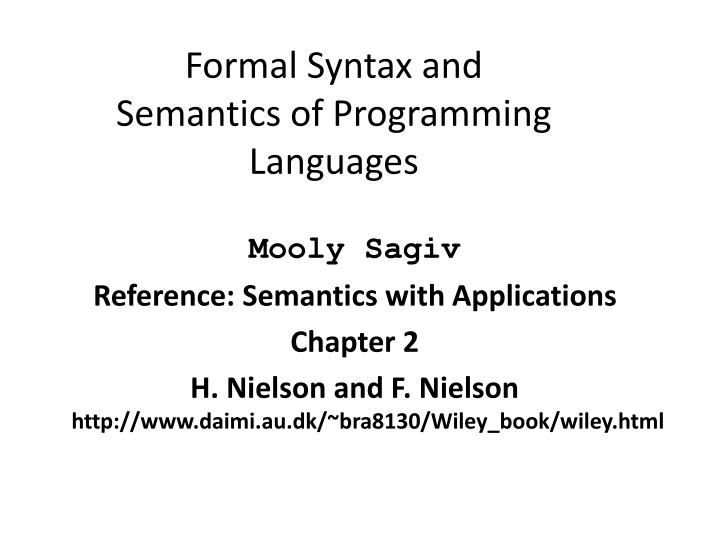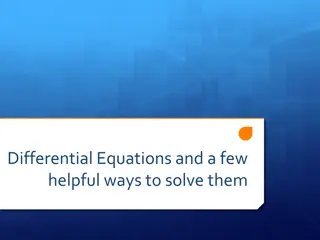
Syntax, Semantics, and Deterministic Semantics of Programming Languages
Explore the formal syntax, natural semantics, and deterministic semantics of programming languages using examples and derivation trees. Understand semantic equivalence and top-down evaluation to find output states efficiently.
Download Presentation

Please find below an Image/Link to download the presentation.
The content on the website is provided AS IS for your information and personal use only. It may not be sold, licensed, or shared on other websites without obtaining consent from the author. If you encounter any issues during the download, it is possible that the publisher has removed the file from their server.
You are allowed to download the files provided on this website for personal or commercial use, subject to the condition that they are used lawfully. All files are the property of their respective owners.
The content on the website is provided AS IS for your information and personal use only. It may not be sold, licensed, or shared on other websites without obtaining consent from the author.
E N D
Presentation Transcript
Formal Syntax and Semantics of Programming Languages Mooly Sagiv Reference: Semantics with Applications Chapter 2 H. Nielson and F. Nielson http://www.daimi.au.dk/~bra8130/Wiley_book/wiley.html
The While Programming Language Abstract syntax S::= x := a | skip | S1 ; S2| if b then S1else S2| while b do S Use parenthesizes for precedence Informal Semantics skip behaves like no-operation Import meaning of arithmetic and Boolean operations
Natural Semantics for While [assns] <x := a, s> s[x A a s] [skipns] <skip, s> s [whileffns] <while b do S, s> s axioms if B b s=ff <S1, s> s , <S2, s > s <S1; S2, s> s <S1, s> s <if b then S1 else S2, s> s [compns] rules [ifttns] if B b s=tt <S2, s> s <if b then S1 else S2, s> s [ifffns] if B b s=ff <S , s> s , <while b do S, s > s <while b do S, s> s [whilettns] if B b s=tt
An Example Derivation Tree <(x :=x+1; y :=x+1) ; z := y), s0> s0[x 1][y 2][z 2] compns <x :=x+1; y :=x+1, s0> s0[x 1][y 2] compns <z :=y,s0[x 1][y 2]> s0[x 1][y 2][z 2] assns <x :=x+1; s0> s0[x 1] <y :=x+1, s0[x 1]> s0[x 1][y 2] assns assns
Top Down Evaluation of Derivation Trees Given a program S and an input state s Find an output state s such that <S, s> s Start with the root and repeatedly apply rules until the axioms are reached Inspect different alternatives in order In While s and the derivation tree is unique
Semantic Equivalence S1and S2 are semantically equivalent if for all s and s <S1, s> s if and only if <S2, s> s Simple example while b do S is semantically equivalent to: if b then (S ; while b do S) else skip
Deterministic Semantics for While If <S, s> s1and <S, s> s2then s1=s2 The proof uses induction on the shape of derivation trees Prove that the property holds for all simple derivation trees by showing it holds for axioms Prove that the property holds for all composite trees: For each rule assume that the property holds for its premises (induction hypothesis) and prove it holds for the conclusion of the rule
The Semantic Function Sns The meaning of a statement S is defined as a partial function from State to State Sns: Stm (State State) SnsS s = s if <S, s> s and otherwise SnsS s is undefined Examples Snsskip s =s Snsx :=1 s = s [x 1] Snswhile true do skip s = undefined
Structural Operational Semantics Emphasizes the individual execution steps <S, i> If the first step of executing the statement S on an input state i leads to Two possibilities for = <S , s > The execution of S is not completed, S is the remaining computation which need to be performed on s = o The execution of S has terminated with a final state o is a stuck configuration when there are no transitions The meaning of a program P on an input state s is the set of final states that can be executed in arbitrary finite steps
Structural Semantics for While [asssos] <x := a, s> s[x A a s] [skipsos] <skip, s> s [comp1sos] <S1, s> <S 1, s > <S1; S2, s> < S 1; S2, s > axioms rules [comp2sos] <S1, s> s <S1; S2, s> < S2, s >
Structural Semantics for While if construct [ifttsos] <if b then S1 else S2, s> <S1, s> if B b s=tt [ifffos] <if b then S1 else S2, s> <S2, s> if B b s=ff
Structural Semantics for While while construct [whilesos] <while b do S, s> <if b then (S; while b do S) else skip, s>
Structural Semantics for While (Summary) [asssos] <x := a, s> s[x A a s] [skipsos] <skip, s> s [ifttsos] <if b then S1 else S2, s> <S1, s> [ifffsos] <if b then S1 else S2, s> <S2, s> [whilesos] <while b do S, s> <if b then (S; while b do S) else skip, s> axioms if B b s=tt if B b s=ff rules [comp1sos] <S1, s> <S 1, s > <S1; S2, s> < S 1; S2, s > [comp2sos] <S1, s> s <S1; S2, s> < S2, s >
Example S=[x S = (z:=x; x := y); y := z 5 , y 7] (z:=x; x := y); y := z, [x 5, y 7] => x := y ; y := z, [x 5, y 7, z 5] comp1sos z:= x; x := y , [x 5, y 7] => x := y ; y := z, [x 5, y 7, z 5] comp2sos asssos z:= x , [x 5, y 7] => [x 5, y 7, z 5]
Example (2ndstep) S=[x S = (z:=x; x := y); y := z 5 , y 7] x := y; y := z, [x 5, y 7, z 5] => y := z, [x 7, y 7, z 5] comp2sos x := y , [x 5, y 7, z 5] => x := y ; y := z, [x 7, y 7, z 5] asssos
Example (3rdstep) S=[x S = (z:=x; x := y); y := z 5 , y 7] y := z [x 7, y 7, z 5] => y := z, [x 7, y 5, z 5] asssos
Factorial Program Input state s such that s x = 3 y := 1; while (x=1) do (y := y * x; x := x - 1) <y :=1 ; W, s> <W, s[y 1]> <if (x =1) then (y := y * x ; x := x 1 else skip); W), s[y 1]> < ((y := y * x ; x := x 1); W), s[y 1]> <(x := x 1 ; W), s[y 3]> < W , s[y 3][x 2]> <if (x =1) then ((y := y * x ; x := x 1); W) else skip, s[y 3][x 2]> < ((y := y * x ; x := x 1); W), s[y 3] [x 2] > <(x := x 1 ; W) , s[y 6] [x 2] > < W, s[y 6][x 1]> <if (x =1) then (y := y * x ; x := x 1); W) else skip, s[y 6][x 1]> <skip, s[y 6][x 1]> s[y 6][x 1]
Finite Derivation Sequences finite derivation sequence starting at <S, i> 0, 1, 2 , ksuch that 0=<S, i> i i+1 k is either stuck configuration or a final state For each step there is a derivation tree 0 k k in k steps 0 * in finite number of steps
Infinite Derivation Sequences An infinite derivation sequence starting at <S, i> 0, 1, 2 such that 0=<S, i> i i+1 Example S = while true do skip s0x = 0
Program Termination Given a statement S and input s S terminates on s if there exists a finite derivation sequence starting at <S, s> S terminates successfully on s if there exists a finite derivation sequence starting at <S, s> leading to a final state S loops on s if there exists an infinite derivation sequence starting at <S, s>
Properties of the Semantics S1and S2 are semantically equivalent if: for all s and which is either final or stuck <S1, s> * if and only if <S2, s> * there is an infinite derivation sequence starting at <S1, s> if and only if there is an infinite derivation sequence starting at <S2, s> Deterministic If <S, s> *s1and <S, s> *s2then s1=s2 The execution of S1; S2on an input can be split into two parts: execute S1on s yielding a state s execute S2on s
Sequential Composition If <S1; S2, s> ks then there exists a state s and numbers k1and k2 such that <S1, s> k1s <S2, s > k2s and k = k1 + k2 The proof uses induction on the length of derivation sequences Prove that the property holds for all derivation sequences of length 0 Prove that the property holds for all other derivation sequences: Show that the property holds for sequences of length k+1 using the fact it holds on all sequences of length k (induction hypothesis)
The Semantic Function Ssos The meaning of a statement S is defined as a partial function from State to State Ssos: Stm (State State) SsosS s = s if <S, s> *s and otherwise SsosS s is undefined
An Equivalence Result For every statement S of the While language SnatS = SsosS
Extensions to While Abort statement (like C exit w/o return value) Non determinism Parallelism Local Variables Procedures Static Scope Dynamic scope
The While Programming Language with Abort Abstract syntax S::= x := a | skip | S1 ; S2| if b then S1else S2| while b do S| abort Abort terminates the execution No new rules are needed in natural and structural operational semantics Statements if x = 0 then abort else y := y / x skip abort while true do skip
Examples <if x = 0 then abort else y := y / x, s> s if s x = 0 then undefined else s [y s y / sx] <skip, s> s For no s: <abort, s> s For no s: <while b do skip, s> s
Undefined semantics in C Pointer dereferences x = *p; if (p !=NULL) x = *p; else abort; Pointer arithmetic x = a[i]; if (i <alloc(a)) x = *(a+i); else abort; Structure boundaries
Undefined semantics in Java? What about exceptions?
Pros and Cons of PLs with Undefined Semantics Benefits Performance Expressive power Simplicity of the programming language Disadvantages Security Portability Predictability Programmer productivity
Formulating Undefined semantics A programming language is type safe if correct programs cannot go wrong No undefined semantics But runtime exceptions are fine For every program P For every input state s one of the following holds: <P, s> *s for some final state s <P, s> i for all i While is type safe and while+abort is not
Conclusion The natural semantics cannot distinguish between looping and abnormal termination (unless the states are modified) In the structural operational semantics looping is reflected by infinite derivations and abnormal termination is reflected by stuck configuration
The While Programming Language with Non-Determinism Abstract syntax S::= x := a | skip | S1 ; S2| if b then S1else S2| while b do S| S1or S2 Either S1or S2is executed Example x := 1 or (x :=2 ; x := x+2)
The While Programming Language with Non-Determinism Natural Semantics [or1ns] <S1, s> s <S1or S2, s> s [or2ns] <S2, s> s <S1or S2, s> s
The While Programming Language with Non-Determinism Structural Semantics
The While Programming Language with Non-Determinism Examples x := 1 or (x :=2 ; x := x+2) (while true do skip) or (x :=2 ; x := x+2)
Conclusion In the natural semantics non-determinism will suppress looping if possible (mnemonic) In the structural operational semantics non- determinism does not suppress not termination configuration
The While Programming Language with Parallel Constructs Abstract syntax S::= x := a | skip | S1 ; S2| if b then S1else S2| while b do S| S1par S2 All the interleaving of S1or S2are executed Examples x := 1 par (x :=2 ; x := x+2) (x := 1; a :=y) par (y := 1; b :=x)
The While Programming Language with Parallel Constructs Structural Semantics [par1sos] <S1, s> <S 1, s > <S1 par S2, s> < S 1par S2, s > [par2sos] <S1, s> s <S1 par S2, s> < S2, s > [par3sos] <S2, s> <S 2, s > <S1 par S2, s> < S1par S 2, s > [par4sos] <S2, s> s <S1 par S2, s> < S1, s >
The While Programming Language with Parallel Constructs Natural Semantics
Conclusion In the natural semantics immediate constituent is an atomic entity so we cannot express interleaving of computations In the structural operational semantics we concentrate on small steps so interleaving of computations can be easily expressed
The While Programming Language with local variables Abstract syntax S::= x := a | skip | S1 ; S2| if b then S1else S2| while b do S| { L S } L ::= var x := a ; L |
Simple Example { var y := 1; (var x := 2 ; { var x := 3 ; y := x + y // 4 } x := y + x // 6 ) }
Another Example while (y > 0) ( { var x := y ; y := x + y; y : = y -1 } x := y + x
Natural Semantics LHS : L 2Var LHS( ) = LHS(var x := a ; L) = {x} LHS(L) s0x if x X s x if x X s0[X s] = [nonens] < , s> s <L , s[x A a s]> s [varns] <var x := a; L, s> s <L , s> s , <S, s > s [blockns] <{ L S }, s> s [LHS(L) s]
Simple Example if (y > 0) then { var x := y +1; y := x + y } else skip ; y := y +x <if (y > 0) ; y := y +x), [x 8, y 5] > [y 17, x 6] compns [y 11, x 6] <y := y +x, [y 17, x 6] [ifttns] <if (y>0) , [x 8, y 5] > [y 11, x 6] <{ var x := y +1; y := x+ y } , [x 8, y 5]< [y 11, x 6] [blockns] <var x := y +1;, [x 8, y 5] > <y := x+y, > [y 5, x 6] [y 5, x 6] [y 11, x 6] [varns] <var x := y +1; , [x 8, y 5] > [y 5, x 6] [nonens]
Structural Semantics ? [blocksos] <begin DvS end, s> s
Conclusions Local Variables The natural semantics can remember local states Need to introduce stack or heap into state of the structural semantics
The While Programming Language with local variables and procedures Abstract syntax S::= x := a | skip | S1 ; S2| if b then S1else S2| while b do S| { L P S } | call p L ::= var x := a ; L | P ::= proc p is S ; P |
Summary SOS is powerful enough to describe imperative programs Can define the set of traces Can represent program counter implicitly Handle gotos Natural operational semantics is an abstraction Different semantics may be used to justify different behaviors Thinking in concrete semantics is essential for language designer/compiler writer/






















